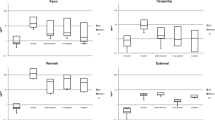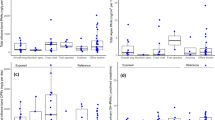Summary
A survey was conducted in the second half of a working week on 33 women who either applied glue (with cyclohexane as an almost exclusive solvent component) or worked in the vicinity of glue application. Carbon cloth-equipped diffusive samplers were used for personal measurement of time-weighted average intensity of exposure to the solvent. The geometric mean and the highest cyclohexane concentration observed in air were 27 ppm and 274 ppm, respectively. Concentrations of cyclohexanol in urine samples and cyclohexane in whole blood and serum collected at the end of a shift showed significant correlations with the solvent exposure levels. Urinary cyclohexanone also correlated, but with a smaller correlation coefficient. The observation suggests that cyclohexanol in urine and cyclohexane in blood or serum collected at the end of a shift are useful indicators of occupational exposure to cyclohexane vapor. Quantitative estimation of balance at the end of the shift suggested that only a minute portion (< 1%) of cyclohexane absorbed is excreted in the urine as cyclohexanol, almost exclusively as a glucuronide. A survey of subjective symptoms revealed an increase in the prevalence of “dimmed vision” and “unusual smell”, but hematology and serum biochemistry testing did not indicate any specific signs.
Similar content being viewed by others
References
American Conference of Governmental Industrial Hygienists (1992) 1992–1993 threshold limit values and biological exposure indices. ACGIH, Cincinnati, Ohio
Bemhard AM, Russis de R, Normand JC, Lauwerys RR (1989) Evaluation of the subacute nephropathy of cyclohexane and other industrial solvents in the female Sprague-Dawley rat. Toxicol Lett 45:271–280
Cai S-X, Huang M-Y, Chen Z, Liu Y-T, Jin C, Watanabe T, Nakatsuka H, Seiji K, Inoue O, Ikeda M (1991) Subjective symptom increase among dry-cleaning workers exposed to tetrachloroethylene vapor. Ind Health 29:111–121
Deutsche Forschungsgemeinschaft (1992) MAK and BAT values 1992. VCH, Weinheim
Elliot TH, Parke DV, Williams RT (1959) Studies in detoxication. 79. The metabolism of cyclo-14C-hexane and its derivatives. Biochem J 72:192–200
Frontali N, Amantini MC, Spagnolo A, Guarcini AM, Saltari MC (1981) Experimental neurotoxicity and urinary metabolies of the C5-C7 aliphatic hydrocarbons used as glue solvents in shoe manufacture. Clin Toxicol 18:1357–1367
Governa M, Calisti R, Coppa G, Tagliavento G, Colombi A, Troni W (1987) Urinary excretion of 2,5-hexanedione and peripheral polyneuropathies in workers exposed to hexane. J Toxicol Environ Health 20:219–228
Hirayama T, Ikeda M (1979) Applicability of carbon felt to the dosimetry of solvent vapor mixture. Am Ind Hyg Ass J 40: 1091–1096
Ikeda M, Kumai M, Aksoy M (1984) Application of carbon felt dosimetry to field studies distant from analytical laboratory. Ind Health 22:53–58
Inoue T (1983) A table for subjective symptom questionnaires for solvent workers (in Japanese). In: Japan Industrial Health and Safety Association (eds) Health management of solvent workers. Japan Industrial Health and Safety Association, Tokyo, pp 66–67
Inoue T, Takeuchi Y, Takeuchi S, Yamada S, Suzuki H, Matsushita T, Miyagaki H, Maeda K, Matsumoto T (1970) A health survey on vinyl sandal manufacturers with high incidence of “n-hexane” intoxication. (Japanese with English abstract) Jpn J Ind Health 12:73–78
Inoue T, Takeuchi Y, Hisanaga N, Ono Y, Iwata M, Ogata M, Saito K, Sakurai H, Hara I, Matsushita T, Ikeda M (1983) A nationwide survey on organic solvent components in various solvent products: Part I. Homogeneous products such as thinners, degreasers and reagents. Ind Health 21:175–183
Jackson S (1966) Creatinine in urine as an index of urinary excretion rate. Health Phys 12:843–850
Japan Association of Industrial Health (1992) Recommend occupational exposure limits. (Japanese, and English translation) Jpn J Ind Health 34:363–384
Kasahara M, Ikeda M (1987) Spontaneous desorption of organic solvents from carbon cloth. Ind Health 25:73–81
Kawai T, Mizunuma K, Yasugi T, Uchida Y, Ikeda M (1990) The method of choice for the determination of 2,5-hexanedione as an indicator of occupational exposure to n-hexane. Int Arch Occup Environ Health 62:403–408
Kawai T, Yasugi T, Mizunuma K, Horiguchi S, Hirase Y, Uchida Y, Ikeda M (1991) Simple method for determination of methanol in blood and its application in occupational health. Bull Environ Contam Toxicol 47:797–803
Koizumi A, Ikeda M (1981) A servomechanism for vapor concentration control in experimental exposure chambers. Am Ind Hyg Ass J 42:417–425
Kumai M, Koizumi A, Saito K, Sakurai H, Inoue T, Takeuchi Y, Hara I, Ogata M, Matsushita T, Ikeda M (1983) A nationwide survey on organic solvent components in various solvent products: Part II. Heterogeneous products such as paints, inks and adhesives. Ind Health 21:185–197
McCann J, Choi E, Yamasaki E, Ames BN (1975) Detection of carcinogens as mutagens in the Salmonella/microsome test: assay of 300 chemicals. Proc Natl Acad Sci 72:5135–5139
Mizunuma K, Kawai T, Yasugi T, Horiguchi S, Iwami O, Ikeda M (1992) In vitro hydrolysis of methyl acetate, a limitation in application of head-space gaschromatography in biological monitoring of exposure. Toxicol Lett 62:247–253
Mutti A, Flazoi M, Lucertini S, Cavatorta A, Franchini I (1981) Absorption and alveolar excretion of cyclohexane in a shoe factory. J Appl Toxicol 1:220–223
Perbellini L, Brugnone F (1980) Lung uptake and metabolism of cyclohexane in shoe factory workers. Int Arch Occup Environ Health 45:261–269
Perbellini L, Brugnone F, Silvestri R, Gaffuri E (1981) Measurement of urinary metabolites of n-hexane, cyclohexane and their isomers by gas chromatography. Int Arch Occup Environ Health 48:99–106
Rainsford SG, Lloyd Davies TA (1965) Urinary excretion of phenol by men exposed to vapour of benzene: a screening test. Br J Ind Med 22:21–26
Saito J, Ikeda M (1988) Solvent constituents in paint, glue and thinner for plastic miniature hobby. Tohoku J Exp Med 155: 275–283
Sandmeyer EE (1981) Alicyclic hydrocarbons. In: Clayton GD, Clayton EE (eds) Patty's industrial hygiene and toxicology, 3rd edn. Wiley-Interscience, New York, pp 3227–3228
Seedorff L, Olsen E (1990) Exposure to organic solvents. I. A survey on the use of organic solvents. Ann Occup Hyg 34:371–378
Seiji K, Jin C, Watanabe T, Nakatsuka H, Ikeda M (1990) Sister chromatid exchanges in peripheral lymphocytes of workers exposed to benzene, trichloroethylene, or tetrachloroethylene, with reference to smoking habits. Int Arch Occup Environ Health 62:171–176
Treon JF, Crutchfield WE Jr, Kitzmiller KV (1943) The physiological response of animals to cyclohexane, methylcyclohexane, and certain derivatives of these compounds. II. Inhalation. J Ind Hyg Toxciol 25:323–347
Uchida Y, Nakatsuka H, Ukai H, Watanabe T, LiuY-T, Huang MY, Wang Y-L, Zhu F-Z, Yin H, Ikeda M (1993) Symptoms and signs of workers exposed predominantly to xylenes. Int Arch Occup Environ Health 64:597–605
Ukai H, Watanabe T, Nakatsuka H, Satoh T, Liu S-J, Qiao X, Yin H, Jin C, Li G-L, Ikeda M (1993) Dose-dependent increase in subjective symptoms among toluene-exposed workers. Environ Res 60:274–289
Yin S-N, Li G-L, Hu Y-T, Zhang X-M, Jin C, Inoue O, Seiji K, Kasahara M, Nakatsuka H, Ikeda M (1987) Symptoms and signs of workers exposed to benzene, toluene or the mixture. Ind Health 25:113–130
Author information
Authors and Affiliations
Rights and permissions
About this article
Cite this article
Yasugi, T., Kawai, T., Mizunuma, K. et al. Exposure monitoring and health effect studies of workers occupationally exposed to cyclohexane vapor. Int. Arch Occup Environ Heath 65, 343–350 (1994). https://doi.org/10.1007/BF00405700
Received:
Accepted:
Issue Date:
DOI: https://doi.org/10.1007/BF00405700




